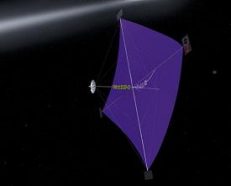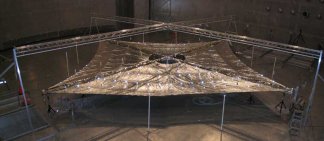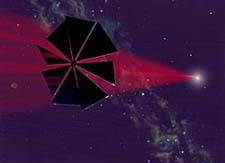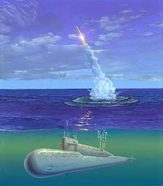Riding Sunlight
A solar sail spacecraft relies on sunlight instead of wind to cruise through space.
By Emily Sohn
Hundreds of years ago, sailing ships carried explorers across the ocean from Europe to America and beyond. A future generation of explorers might set sail, too—not across water, but across outer space.
Later this year, researchers plan to test a solar sail spacecraft that uses sunlight instead of wind to move.
In theory, spacecraft pushed by light could cruise at high speeds without using any fuel. Fast and practical travel to other planets and even stars might then become possible.
 |
|
Solar sails, like the ones on the Cosmos 1 spacecraft, could use sunlight to push a vehicle through space. |
| Babakin Space Center, © The Planetary Society |
The first solar sail flight could be monumental, says Louis Friedman. It could have the same sort of impact as the pioneering airplane flight made by the Wright brothers in 1903.
Before the Wright brothers and other inventors showed the way, the idea of humans in flight seemed ridiculous to many people. A hundred years later, passenger jets and private planes crisscross the sky all day long.
Now, it’s the idea that sunlight can propel spacecraft that many people find hard to believe. Friedman and others are trying to turn this crazy idea into reality.
The biggest challenge is figuring out how to do what you know should be possible, Friedman says. The forces are there. It’s a matter of harnessing them. Friedman heads the Cosmos 1 solar sail project. He’s also executive director of The Planetary Society in Pasadena, Calif.
“The Wright brothers flew for 12 seconds,” Friedman says. “They went nowhere, but they were successful. If we can fly for just 2 days, it’ll be a success.”
Solar pressure
Sailing in space is similar to sailing on water, with two major differences. There’s no water in space. And there’s no wind.
This may sound confusing because there is something called a solar wind. Unlike the breezes we’re used to on Earth, however, the solar wind is a stream of particles spit out by the sun. Magnetic fields help protect our planet from these particles.
Solar sailing has nothing to do with the solar wind. Instead, solar sails catch rays of light.
 |
|
This illustration shows a NASA-developed design for a solar sail that would use sunlight to propel a spacecraft. |
| NASA/MSFC |
It may be hard to imagine, but sunlight itself can make objects move. Light is a form of energy, and it exerts pressure.
We don’t feel the pressure of sunlight on Earth because other forces that act on us are much stronger. Outer space, however, is practically empty. Nothing gets in the way of the force exerted by light.
Understanding how solar sails work also hinges on a law of physics discovered by Isaac Newton in the 1600s. His third law of motion states that for every action, there’s an equal and opposite reaction.
For example, when you let air out of a balloon, the air shoots out in one direction and the balloon zips off in the opposite direction. On a skateboard, pushing your foot back makes the board go forward.
 |
|
Last August, in a NASA project involving solar sails, researchers spread out the four blades of a giant solar sail for testing in a vacuum chamber. |
| NASA/L’Garde, Inc. |
Solar sails have mirror-like blades that reflect sunlight. When light gets reflected back in one direction, the sail moves in the opposite direction.
Light travel
Light exerts only a tiny amount of force. So, to get a real push, a solar sail must be as large and lightweight as possible.
The solar sail developed by Friedman’s team is made of a very light, shiny plastic. It has eight blades, arranged in a circle. Each blade is 15 meters (50 feet) long and even thinner than an ordinary garbage bag.
 |
|
A sail design similar to that on Cosmos 1 may eventually send a spacecraft to the stars, powered by a giant laser. |
| Painting by Michael Carroll, © The Planetary Society |
At first, a solar sail might travel at no more than a few millimeters a second—slower than a snail. With nothing in space to slow it down, though, the sail could, in theory, reach speeds as high as 100,000 miles per hour, Friedman says. That would be fast enough to get to other planets in just a few years.
Changing the angle of its sails would allow the spacecraft to change direction. It’s like using a rudder to control a boat’s direction.
Launch date
Friedman’s team plans to launch its solar sail spacecraft, Cosmos 1, in March. This will be the first attempt to get light pressure to propel a vehicle in outer space.
 |
|
The Cosmos 1 spacecraft will be launched from a submarine. |
| Painting by Michael Carroll, © The Planetary Society |
People are skeptical. “Even I’m not sure the first attempt will succeed,” Friedman says. “But I don’t think anyone thinks the theory is wrong.”
Friedman imagines a day in the distant future when solar sails would crowd space in the same way that airplanes crowd the sky on Earth today. For now, he and his team would be happy to take even a small step toward an entirely new category of space exploration.
“We know with other inventions that people try, fail, try again, and then succeed,” Friedman says.
The dramatic flight of Cosmos 1 is coming up. It may turn out to be the start of a great adventure.
UPDATE: Cosmos 1 was launched from a Russian submarine on June 21, 2005. Unfortunately, the rocket carrying the solar sail spacecraft failed and Cosmos 1 didn’t make it into orbit. See http://www.planetary.org/solarsail/ for additional information.
Going Deeper:







